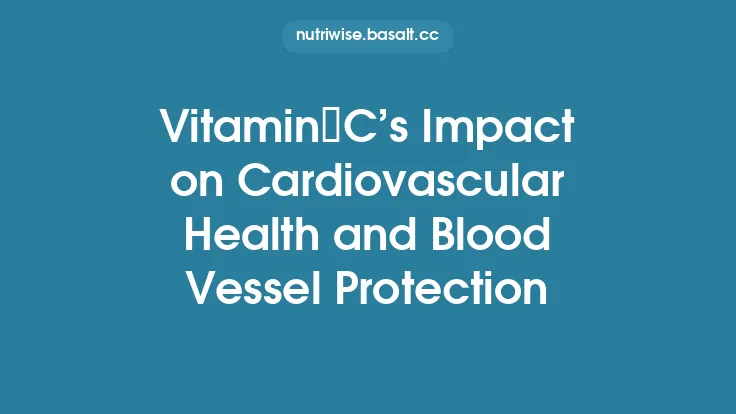Vitamin C is widely recognized for its pivotal role in maintaining healthy skin, primarily through its influence on collagen production. Collagen, the most abundant protein in the dermis, provides structural support, elasticity, and resilience to the skin. When collagen synthesis is optimal, the skin appears firm, smooth, and youthful, while deficiencies can lead to premature wrinkling, loss of tone, and impaired wound healing. Understanding how vitamin C drives collagen formation and supports overall skin health offers valuable insight for anyone seeking to preserve or improve their complexion over the long term.
The Biochemistry of Collagen Synthesis
Collagen biosynthesis is a multistep process that begins inside fibroblasts, the primary cells responsible for producing the extracellular matrix (ECM) of the dermis. The pathway can be summarized in three major phases:
- Pre‑procollagen formation – Ribosomes translate the COL1A1 and COL1A2 genes into pre‑pro‑α‑chains, which contain signal peptides that direct the nascent polypeptides into the endoplasmic reticulum (ER).
- Post‑translational modifications – Within the ER, the α‑chains undergo hydroxylation of specific proline and lysine residues, glycosylation of hydroxylysine, and formation of disulfide bonds that stabilize the triple‑helical structure.
- Extracellular assembly – The modified procollagen molecules are secreted into the extracellular space, where N‑ and C‑terminal propeptides are cleaved by specific proteinases, allowing the mature collagen fibrils to self‑assemble and cross‑link, forming robust fibers that integrate into the dermal matrix.
Each of these stages is tightly regulated, and any disruption can compromise the quality or quantity of collagen produced. Vitamin C exerts its most critical influence during the post‑translational modification phase, where it serves as a cofactor for the enzymes that hydroxylate proline and lysine residues.
Vitamin C as an Essential Cofactor for Hydroxylation
Two iron‑dependent enzymes—prolyl‑4‑hydroxylase (P4H) and lysyl‑hydroxylase (LH)—catalyze the addition of hydroxyl groups to proline and lysine residues, respectively. These hydroxylations are indispensable for several reasons:
- Stabilization of the triple helix – Hydroxyproline residues form hydrogen bonds that lock the three α‑chains into a rigid, rod‑like configuration. Without sufficient hydroxylation, the helix is unstable and prone to degradation.
- Cross‑linking of collagen fibrils – Hydroxylysine serves as a site for glycosylation and later for the formation of covalent cross‑links between adjacent collagen molecules, which confer tensile strength to the dermal matrix.
The catalytic cycle of P4H and LH requires Fe²⁺ as a cofactor, α‑ketoglutarate as a co‑substrate, molecular oxygen, and, crucially, ascorbate (the reduced form of vitamin C). Ascorbate maintains the iron atom in its ferrous (Fe²⁺) state by donating electrons, preventing its oxidation to Fe³⁺, which would render the enzymes inactive. In the absence of adequate vitamin C, the hydroxylation reaction stalls, leading to under‑hydroxylated collagen that is rapidly degraded by intracellular quality‑control mechanisms. This biochemical bottleneck explains why severe vitamin C deficiency (scurvy) manifests with fragile skin, petechiae, and impaired wound healing.
Impact on Fibroblast Function and Extracellular Matrix
Beyond its enzymatic cofactor role, vitamin C influences fibroblast behavior at the transcriptional and signaling levels:
- Gene expression modulation – Ascorbate can up‑regulate COL1A1 and COL3A1 transcription, increasing the cellular output of collagen precursors. It also stimulates the expression of elastin and fibronectin, other key ECM proteins that work synergistically with collagen.
- Proliferation and migration – Vitamin C promotes fibroblast proliferation and enhances their migratory capacity, both essential for efficient wound closure and tissue remodeling.
- Matrix metalloproteinase (MMP) balance – While MMPs are necessary for normal ECM turnover, excessive activity degrades collagen and accelerates skin aging. Vitamin C has been shown to down‑regulate MMP‑1 and MMP‑3 expression, helping preserve existing collagen fibers while new ones are synthesized.
Collectively, these actions create a microenvironment that favors the deposition of high‑quality collagen and maintains the structural integrity of the dermis.
Skin Barrier Integrity and Moisture Retention
Collagen fibers form a scaffold that supports the epidermis and the stratum corneum, the outermost barrier layer. A robust collagen network contributes to:
- Mechanical resilience – The dermal scaffold distributes mechanical stress, reducing the formation of micro‑tears that can lead to visible lines and creases.
- Hydration homeostasis – Collagen binds water molecules through its triple‑helical structure, helping to retain dermal moisture. Adequate hydration maintains skin turgor and smoothness, while dehydration accentuates fine lines.
When vitamin C–dependent collagen synthesis is optimal, the skin barrier remains tight and well‑hydrated, translating into a plumper, more radiant appearance.
Photoprotection and Antioxidant Defense in the Dermis
Although the primary focus of this article is collagen, it is worth noting that vitamin C’s antioxidant capacity directly supports collagen integrity. Ultraviolet (UV) radiation generates reactive oxygen species (ROS) that can:
- Oxidize collagen fibers, weakening their structure.
- Activate signaling pathways (e.g., AP‑1) that increase MMP expression, accelerating collagen breakdown.
By scavenging ROS in the dermal compartment, vitamin C reduces oxidative damage to existing collagen and curtails the UV‑induced up‑regulation of MMPs. This dual action—protecting existing collagen while enabling the synthesis of new fibers—makes vitamin C a cornerstone of photoprotective skin care strategies.
Clinical Evidence Linking Vitamin C to Skin Appearance
A substantial body of clinical research has examined the relationship between vitamin C status (both systemic and topical) and measurable skin outcomes:
| Study Design | Population | Intervention | Main Findings |
|---|---|---|---|
| Randomized, double‑blind, placebo‑controlled trial (12 weeks) | 60 women, ages 35‑55 | Oral 500 mg vitamin C daily | 15 % increase in dermal collagen density (measured by high‑frequency ultrasound) and significant reduction in wrinkle depth |
| Split‑face study (8 weeks) | 30 men, ages 30‑45 | 20 % L‑ascorbic acid serum applied twice daily on one side | Greater improvement in skin firmness (cutometer readings) and brighter complexion on treated side |
| Open‑label pilot (6 months) | 20 patients with chronic wounds | Combined oral (1 g) and topical (10 % ascorbate) vitamin C | Accelerated wound closure (average 30 % faster) and higher tensile strength of healed tissue |
| Meta‑analysis (15 trials, n = 1,200) | Mixed ages | Vitamin C supplementation (≥200 mg/day) | Consistent modest improvements in skin elasticity and reduction in photo‑aging markers |
These studies collectively demonstrate that sufficient vitamin C—whether delivered systemically, topically, or both—correlates with measurable enhancements in collagen content, skin firmness, and overall visual appearance. Importantly, the magnitude of benefit appears dose‑dependent, with higher concentrations (especially in topical formulations) yielding more pronounced effects.
Topical Vitamin C: Formulations and Stability Considerations
Topical delivery circumvents the gastrointestinal tract and can achieve much higher local concentrations of vitamin C in the epidermis and upper dermis. However, ascorbic acid is chemically unstable, readily oxidizing when exposed to air, light, or alkaline pH. Formulation science addresses these challenges through several strategies:
- pH optimization – Ascorbic acid is most stable and penetrative at a low pH (≈3.0). Formulations that maintain this acidity improve skin absorption while minimizing oxidation.
- Encapsulation technologies – Liposomes, nanocarriers, and polymeric microspheres protect the molecule from environmental exposure and facilitate controlled release into deeper skin layers.
- Derivative compounds – Ascorbyl‑2‑phosphate, magnesium ascorbyl phosphate, and tetra‑isosorbide decarboxylate are more stable, water‑soluble derivatives that convert to active ascorbate after skin penetration. While they may be less potent per unit weight, their enhanced stability can result in comparable biological activity over time.
- Antioxidant synergists – Adding ferulic acid or vitamin E (tocopherol) to a vitamin C serum can stabilize the ascorbate and provide complementary antioxidant protection.
When selecting a topical product, consumers should look for:
- Clear labeling of concentration (≥10 % L‑ascorbic acid is generally considered efficacious).
- Packaging that limits light and air exposure (opaque, air‑tight pump bottles).
- A low pH (ideally 2.5–3.5) and minimal added fragrance or irritants, especially for sensitive skin types.
Practical Recommendations for Optimizing Skin Collagen
To harness vitamin C’s collagen‑boosting potential, a combined systemic and topical approach is advisable:
| Action | Rationale | Practical Tips |
|---|---|---|
| Maintain adequate dietary intake | Provides the baseline ascorbate needed for intracellular hydroxylation. | Include citrus fruits, berries, kiwi, bell peppers, and leafy greens daily. |
| Consider oral supplementation when dietary intake is insufficient | Ensures systemic availability for fibroblasts throughout the body. | 200–500 mg of high‑quality L‑ascorbic acid taken with meals; avoid excessive doses (>2 g) that may cause gastrointestinal upset. |
| Incorporate a stable topical vitamin C serum | Delivers high concentrations directly to the skin, enhancing local collagen synthesis and photoprotection. | Apply a 10–20 % L‑ascorbic acid serum each morning after cleansing, followed by sunscreen. |
| Use sunscreen daily | UV radiation degrades collagen and oxidizes vitamin C; protection preserves both. | Broad‑spectrum SPF 30+ applied 15 minutes before sun exposure. |
| Support complementary nutrients | Cofactors such as copper, zinc, and vitamin K are involved in collagen cross‑linking and skin health. | A balanced diet or a broad‑spectrum skin‑health supplement can provide these micronutrients. |
| Monitor skin response | Individual tolerance varies; over‑application can cause transient irritation. | Start with once‑daily application, gradually increase to twice daily if tolerated. |
Adhering to these guidelines can maximize the enzymatic efficiency of collagen production, improve the structural quality of the dermal matrix, and ultimately yield smoother, firmer skin.
Potential Pitfalls and Safety Considerations
While vitamin C is generally safe, certain factors merit attention:
- Irritation and sensitization – High‑strength L‑ascorbic acid (≥20 %) can cause stinging, redness, or contact dermatitis, especially on compromised skin. Patch‑testing new products is advisable.
- Oxidation of the product – Once a vitamin C serum oxidizes (turns yellow or brown), its efficacy diminishes, and it may become irritating. Discard any product that shows color change or an off‑odor.
- Interactions with topical acids – Concurrent use of strong alpha‑hydroxy acids (AHAs) or beta‑hydroxy acids (BHAs) can lower skin pH further, increasing irritation risk. Staggering application times (e.g., vitamin C in the morning, AHAs at night) can mitigate this.
- Medical conditions – Individuals with hemochromatosis (iron overload) should consult a healthcare professional before high‑dose oral vitamin C, as ascorbate can enhance iron absorption.
By recognizing these considerations and adjusting usage accordingly, most users can safely benefit from vitamin C’s collagen‑supporting properties.
In summary, vitamin C is indispensable for the enzymatic steps that generate stable, functional collagen fibers, and it further enhances fibroblast activity, protects existing collagen from oxidative damage, and improves the overall architecture of the skin’s extracellular matrix. Through a combination of adequate systemic intake and well‑formulated topical application, individuals can leverage this micronutrient to maintain skin firmness, elasticity, and a youthful appearance throughout life.





